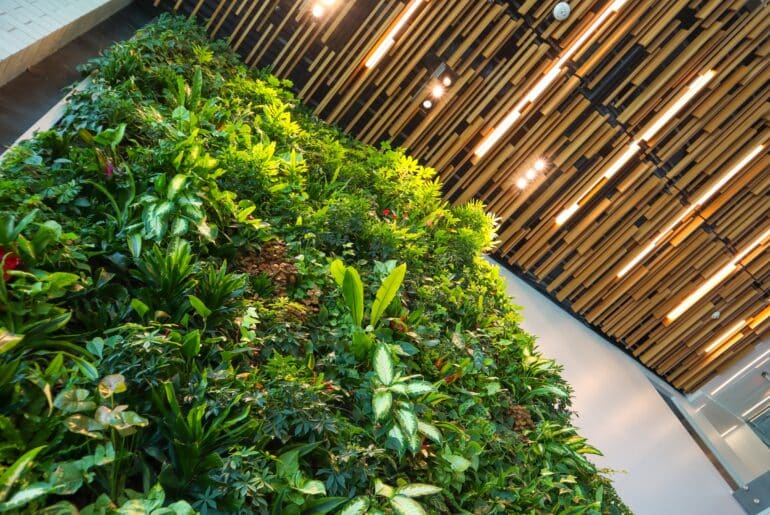This year, USGBC’s GreenerBuilder hit home with the Brené Brown-inspired message that it’s critical to lead with courage and vulnerability as we forge a better future through our built environment and beyond. Environmentalist and leader of Project Drawdown, Paul Hawken built on this call to action in his keynote, urging everyone to lead as climate change has finally shifted to the center of the social eye.
Five major themes in high-performance real estate rose to the top from this year’s conference in San Francisco, presenting bold solutions for the sustainable built environment that tackle environmental, social, and economic challenges in California and at the global scale.
#1: EMBODIED CARBON COMES FIRST
Interface’s Mikhail Davis, Gensler’s Kristen Ritchie, and Skanska’s Stacy Smedley discussed the intersection of materials specifications with recognizing and acting on the time value of carbon. Driving the session was the rattling reality that “although operational emissions account for more of a building’s carbon footprint over its entire life, between now and 2030, almost 75% of the carbon footprint of the 900B SF [of new buildings and major renovations that’ll be constructed globally over the next 15 years] will be from embodied carbon, not operational emissions.”
So, if we’re going to tackle carbon NOW, we need to start to seriously address embodied carbon, which accounts for emissions associated with the production, transportation, and installation of building materials. Sitting at the nexus of energy performance and material transparency, embodied carbon can play a major role in climate change mitigation efforts from environmental and human health perspectives alike through effective reduction strategies. But how?
As Gensler’s Kristen Ritchie put it, “If you don’t spec it, you won’t get it.” Discussing the concept and impact of embodied carbon at the beginning of the bidding process and incorporating particular requirements related to embodied carbon as part of the specification is a critical first step in effectively reducing it on a project. Presenters shared an exemplary project in which as part of the bid, the owner requested an EPD be submitted along with the bid. As part of the winning bid, both cost and carbon impact were analyzed.
To execute such analysis, the Carbon Leadership Forum’s EC3 tool (Embodied Carbon in Construction Calculator) provides an open source database for construction materials and their associated environmental impact, including embodied carbon. The tool is currently in development but will be designed to pull in EPDs to its database directly from the organizations that grant them, and Autodesk will also conveniently plug into the tool. The EC3 is set to be available to the public in November 2019 and will serve as a key tool for project teams to effectively address embodied carbon.
#2: GO ALL-IN ON ALL-ELECTRIC
Embodied carbon clearly plays a critical role in near-term GHG emission reductions, but don’t you dare forget about operational carbon! As noted above, operational emissions account for a large majority of a building’s carbon footprint over its entire life, so we must continue to simultaneously home in on innovative operational carbon reduction strategies.
In this vein, electrification has emerged as a key component of Net Zero Carbon efforts, and experts are accordingly beginning to dig in.
In a rather electrifying session led by Salesforce’s Amanda von Almen, EDF Renewables’ Michael Robinson, and Russell Carr, the group dove into electrification through a conversation around utility rates, various energy storage business models, the energy storage load profile analysis process, and energy storage facility selection parameters. In further discussion of a Salesforce office case study, the team shared the resiliency strategies used to navigate the risk factors associated with electrification, as well as the expected benefits and ROI of leveraging battery energy storage to reduce their demand charges.
This comes on the heels of Berkeley’s historic move to ban natural gas hook-ups in new buildings starting January 1, 2020. Passed in support of reaching the state’s goal of 100% zero carbon energy by 2045, the mandate opens the door for wide-scale building electrification and grid decarbonization. As the saying goes, “as goes Berkeley, so goes California, and so goes the country.” A growing number of Bay Area cities, including San Jose, Santa Rosa, and San Francisco, are also considering the move away from natural gas to help meet climate goals. As the movement gains steam and legislative teeth, we can expect all-electric buildings to play a larger role in the high-performance building industry on the west coast and nationwide.
#3: HEALTH REQUIRES A HOLISTIC APPROACH
Broadening the scope of sustainability beyond energy and carbon, health and wellness continue to dominate many high-performance building discussions with reflections on progress to date as well as existing gaps and future needs.
In the near vicinity of GreenerBuilder, the Green Health Partnership hosted a Health & Well-being Roundtable with USGBC’s Kelly Worden and ArcSkoru’s Chris Pyke. The event brought together property companies, corporate occupiers, and technology solution providers to discuss the development of health-promoting buildings and communities.
The roundtable revealed an agreement that while engagement on occupant health is high and only increasing, it continues to lack a uniform definition and is often missing a holistic approach. There are many ways to define occupant health and wellness and as such, we’re doing it differently. Consequently, some critical areas for health and wellness fall through the cracks and present opportunity for an improved approach.
At the forefront is equity. The industry has made significant progress addressing certain domains of health and well-being—including the impact of materials on indoor air quality—but we still have significant work to do around promoting health equity. There is need to expand health and wellness beyond tech environments and offices, to broader and more diverse populations and spaces with a dire need for a healthy and safe environment. By utilizing a variety of impact metrics and engaging a diverse set of stakeholders, practitioners can begin to address health in buildings and communities with a more impactful social equity lens.
This growth in occupant-centric design from offices to other building types sheds light on another area for opportunity: alleviating stress through healthy buildings. When we talk about healthy offices, enhanced productivity often dominates the conversation. However, designers and project practitioners are encouraged to think beyond metrics focused on increasing productivity and additionally about how design can alleviate stress and create an overall better environment for all occupants, suggesting the need for a more holistic health metric. HOK’s Mara Baum will expand on the topic of addressing rising technostress by designing for mindfulness at Greenbuild in Atlanta.
#4: RESILIENCY IS ON THE RISE
Climate change mitigation through strategies above like embodied carbon reduction and going all-electric has topped the list of priorities for the green building industry for decades, but a practical shift toward resiliency is on the rise. In a session indicative of an overall shift in mentality from mitigation to adaptation—ultimately “how do we stop climate change?” to “how do we survive when the climate changes?,” Elaine Aye and Evan Reis dove into how project teams can create resilient design and operations in an era of climate change.
Elaine Aye approached resiliency from her position as a Regional Manager at RWDI. Traditionally known for building enclosure modeling and analysis, RWDI engages in resiliency work ranging from sustainability certifications to helping buildings withstand increasingly intense storms as the climate crisis worsens.
Evan Reis from the U.S. Resiliency Council (USRC) reminded us that resiliency isn’t necessarily tied to climate and has always played an important role in design decisions. In California especially, earthquake resiliency has always been key to safe, effective building design and construction. This concept introduces the need for more resiliency frameworks overall that tie in both climate and non-climate aspects. In alignment, the USRC has released an earthquake resiliency rating system and is planning to develop other resiliency frameworks in the coming years.
These resources can guide designers and practitioners in designing and operating more resilient, safe, and adaptive buildings. Some other powerful resiliency frameworks include:
• The Functional Recovery Conceptual Framework is EERI’s white paper to support design for functional recovery to assess and improve community resilience
• USGBC’s Center for Resilience initiative
• RELi 2.0 Rating Guidelines for Resilient Design and Construction
Resiliency was also a big point of discussion at COP 24 when many of the world’s leaders were forced to come to terms with the fact that even if we were on track to meeting our climate goals, we would still miss our 2 degree target by a long shot, as made alarmingly clear by this terrifying infographic from the UN Gap Report. Thus, resiliency frameworks should be increasingly considered to guide design decisions and support not only short-term safety but also long-term planning and adaptation.
#5: SUPPORTING SUSTAINABILITY AT SCALE
Tackling embodied carbon, electrification, holistic health, and resiliency through our building stock is challenging enough on single building projects, but how can we support it at scale? If we are to fully and effectively respond to the climate crisis, strategic, sustainable (ideally, regenerative) steps must be made across entire real estate portfolios.
To address sustainability at scale, Stok’s Devon Bertram and HP’s Mary Curtiss outlined key factors for successful sustainable real estate programs. Crafting, implementing, and managing a sustainability program for a company’s building portfolio is a critical but daunting task, and Stok’s study of over 15 leading brands reveals that a few key factors—communication, stakeholder buy-in, a standardized program, and data—overwhelmingly impact outcomes at different stages of a program. Understanding these key factors allows owners, occupiers, and project teams to focus their efforts and ensure program success.
As a leader in corporate sustainability, HP has embedded sustainability into each phase of their real estate assets, from a sustainability site selection checklist, to a sustainable construction playbook, to renewable energy sourcing. Taking a streamlined programmatic approach sets the company up to meet their target of LEED v4 certification for all new sites, among many other sustainability goals that are intertwined through their real estate.
To help owners, occupiers, and project teams achieve greater environmental, social, and financial impact through their real estate, Stok is launching a Sustainable Real Estate Programs Handbook that outlines the key factors for success at each program phase, as well as associated action steps for project teams. Stay tuned for more information or send us a message to learn more about the handbook!
#6: BARACK BONUS!
We said five themes, but that was before the USGBC announced that Barack Obama will keynote Greenbuild in Atlanta this fall. We’re excited to continue these conversations on the national stage and hear solutions for a sustainable future from green building practitioners and former Presidents alike.
Join us in Atlanta, where Jeremy Attema will provide insights into the next wave of sustainability. In the meantime, reach out to keep these important discussions going!



